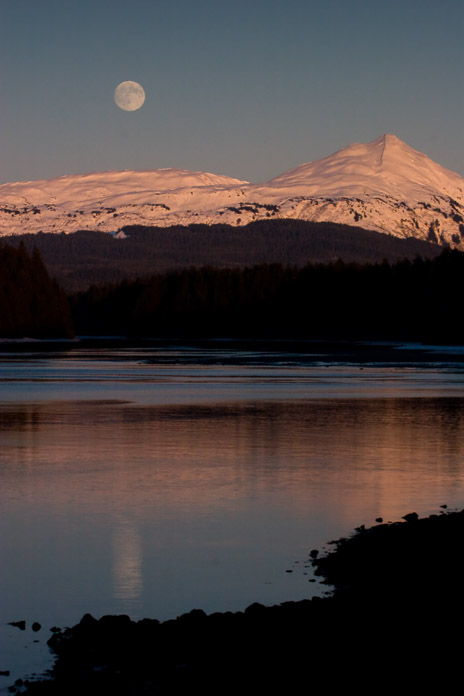
满月从公园总部附近的Bartlett Cove(巴列特湾)上升起。每天四次, 这个阶段的月亮会引起一些世界上最猛烈的潮汐。在这张照片里,我们看到一个数英尺低(一到三米)的“负”潮。换言之,潮汐低于“平均低潮面”。这种情况会在新月和满月时发生。在Glacier Bay(冰川湾),潮汐在仅仅六个多小时内可有多达24英尺(7.3米)的垂直高度的变化,造成强大的洋流并暴露出潮水下和潮间带的大量海洋生物。
La luna llena elevándose sobre Bartlett Cove (caleta Bartlett), cerca de la sede del parque. Cuatro veces al día, la luna en esta fase crea unas de las mareas más intensas del mundo. En esta foto, vemos una marea "negativa” de unos pocos metros. En otras palabras, la marea está por debajo del nivel de "Bajamar Media", lo que sucede con las lunas nuevas y llenas. En Glacier Bay, las mareas pueden cambiar tanto como en 24 pies de altura (731 cm) en poco más de seis horas, y crean unas fuertes corrientes oceánicas que dejan al descubierto una amplia gama de vida marina sub e intermareal.
A full moon rises above Bartlett Cove, near the park’s headquarters. Four times a day, the moon in this phase will create some of the world’s most extreme tides. In this photo, we see a “minus” tide of a few feet. In other words, the tide has fallen below the “Mean Low Water” level. This happens around new and full moons. In Glacier Bay, the tides can change as much as 24 vertical feet in just over six hours, creating strong ocean currents and exposing a vast array of sub and intertidal marine life. Photographer: Sean Neilson